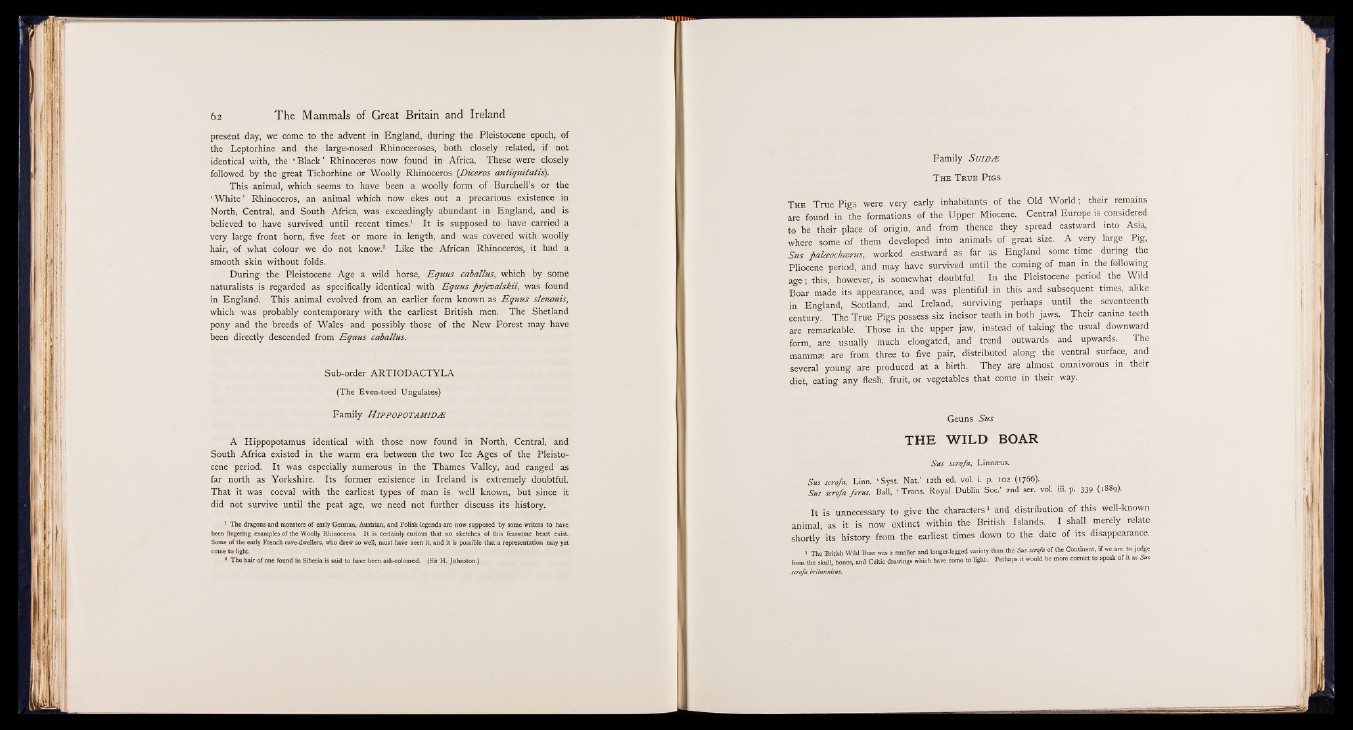
present day, we come to the advent in England, during the Pleistocene epoch, of
the Leptorhine and the large-nosed Rhinoceroses, both closely related, if not
identical with, the ‘ Black’ Rhinoceros now found in Africa. These were closely
followed by the great Tichorhine or Woolly Rhinoceros (Diceros antiquitatis).
This animal, which seems to have been a woolly form of Burchell’s or the
‘ White ’ Rhinoceros, an animal which now ekes out a precarious existence in
North, Central, and South Africa, was exceedingly abundant in England, and is
believed to have survived until recent times.1 It is supposed to have carried a
very large front horn, five feet or more in length, and was covered with woolly
hair, of what colour we do not know.2 Like the African Rhinoceros, it had a
smooth skin without folds.
During the Pleistocene Age a wild horse, Equus caballus, which by some
naturalists is regarded as specifically identical with Equus prjevalskii, was found
in England. This animal evolved from an earlier form known as Equus stenonis,
which was probably contemporary with the earliest British men. The Shetland
pony and the breeds of Wales and possibly those of the New Forest may have
been directly descended from Equus caballus.
Sub-order ARTIODACTYLA
(The Even-toed Ungulates)
Family H iP P O P O TAMIDJE
A Hippopotamus identical with those now found in North, Central, and
South Africa existed in the warm era between the two Ice Ages of the Pleistocene
period. It was especially numerous in the Thames Valley, and ranged as
far north as Yorkshire. Its former existence in Ireland is extremely doubtful.
That it was coeval with the earliest types of man is well known, but since it
did not survive until the peat age, we need not further discuss its history.
1 The dragons and monsters of early German, Austrian, and Polish legends are now supposed by some writers to have
been lingering examples of the Woolly Rhinoceros. It is certainly curious that no sketches of this fearsome beast exist.
Some of the early French cave-dwellers, who drew so well, must have seen it, and it is possible that a representation may yet
come to light.
* The hair of one found in Siberia is said to have been ash-coloured. (Sir H. Johnston.)
Family SuiDÆ
T he T rue Pigs
T he True Pigs were very early inhabitants of the Old World; their remains
are found in the; formations of the Upper Miocene. Central Europe is considered
to be their place of ^rigin, and from thence they spread eastward into Asia,
where some of them developed into .animals of great size. A very large Pig,
Sus palaocharus, worked eastward as far as England some time during the
Pliocene period, and may have survived until the coming of man in the following
age; this, however, is somewhat doubtful. In the Pleistocene period the Wild
Boar made its appearance, and was plentiful in this and subsequent times, alike
in England, Scotland, and Ireland, surviving perhaps until the seventeenth
century. The True Pigs possess six incisor teeth in both jaws. Their canine teeth
are remarkable. Those in the upper jaw, instead ..of taking the usual downward
form, are usually much elongated, and trend outwards and upwards. The
mammae are from three to 4 five pair, distributed along the ventral surface, and
several young are produced at a birth. They are almost omnivorous in their
diet, eating any flesh, fruit, or vegetables that come in their way.
Geuns Sus
T H E W IL D BOAR
Sus scrofa, Linnaeus.
Sus scrofa, Linn. ■ S y s t Nat.’ 12th ed. vol. i. p. 102 (1766).
Su s scrofa fern s, Ball, ’ Trans. Royal Dublin Soc.' and ser. vol. i|i|p. 339 (1889).
It is unnecessary to give the characters1 and distribution of this well-known
animal, as it is now extinct within the British Islands. I shall merely relate
shortly its history from the earliest times down to the date of its disappearance.
1 The British Wild Boar was a smaller and longer-legged variety than the S o scrofa 6f the Continent, if we are to judge
from the skull, bones, and Celde drawings which have come to light. Perhaps it would be more correct to speak of rt as S o
scrofa britannicus.